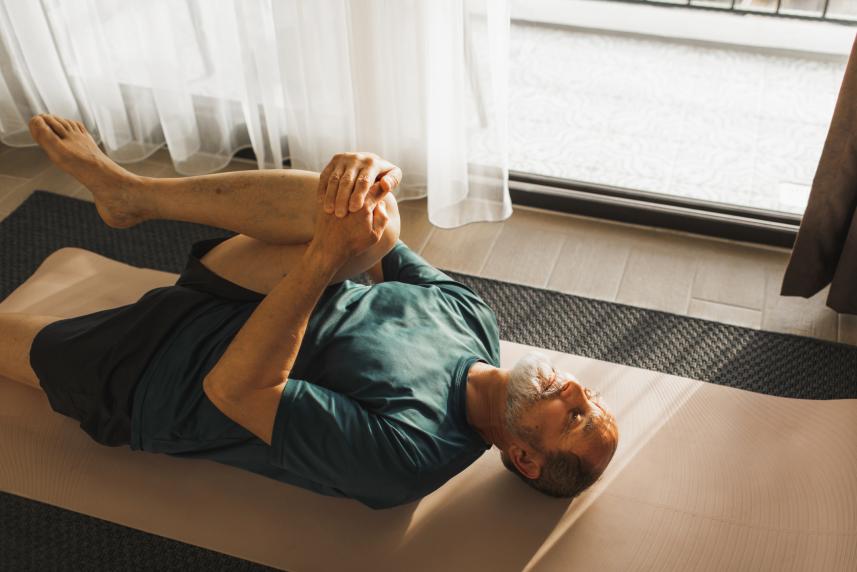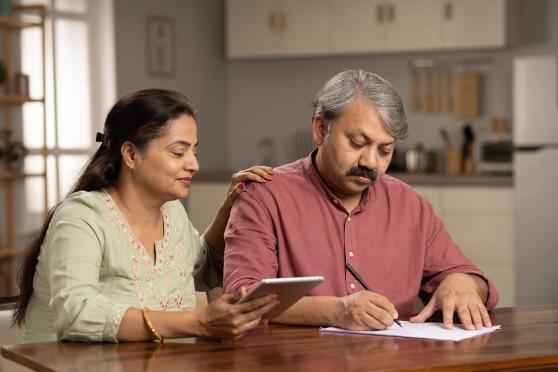Five stretches to ease lower back pain
When muscle spasms, tightness, or discomfort in your hips is holding you back from the activities you love, it’s time to take action. Learn about the possible causes of lower back pain and the simple stretches that can help you find relief.

Lower back pain is annoyingly common. And while some cases of lower back pain can be quite extreme and require surgery, the good news is that about 90% of cases improve without it.
Your lower back, or lumbar spine, is composed of five vertebrae at the base of the spine that are insulated by small, cushioning discs and are attached to ligaments and muscles.
These muscles are part of your core, which includes the oblique and abdominal muscles. Lower back pain originating in these muscles can be lessened or improved with simple stretches.
While we tend to think lower back pain stems from heavy lifting or bending over to pick something up, one common cause is more benign: sitting.
“Most people, when they work, sit all day, and it causes tight hamstrings and weak glutes. Everything is connected in the body, so if you mess up one thing in your body, it affects another,” says Katrina Smith, a National Academy of Sports Medicine–certified trainer in New York City.
When you sit, your hip muscles and glutes are constantly shortened, which pulls on your pelvis. In turn, that strains the muscles in your lower back, Smith says.
You can loosen your lower back, hamstring, and glute muscles to help relieve pain, with these five stretches from Smith. Do them before heading to bed or after a workout. Go through them in order, holding each for at least a minute. The tighter your back, the more sensation you may feel. If the pain is sharp and doesn’t feel like normal stretching, stop and call your doctor.
Knees to chest
Lie on your back and pull your knees into your chest. Wrap your arms around your legs just below the knees and grasp your elbows, if possible. If that feels too tight, try doing one leg at a time.
Forward fold
Stand with your feet hip-width distance apart. Hinge forward at the hips and hang with your arms straight and down. The goal isn’t to touch your toes, but simply to let gravity loosen your lower back, hamstrings, and glutes, Smith says. Hang as low as you can to get a stretch, but don't force your body into it.
Child’s pose
Sit on your shins, with your bottom on your feet. Bend forward at the waist and place your forehead on the ground. If you can’t quite reach, use a stack of books to rest your head down. Walk your arms out in front of your head as far as you can with your hands flat on the ground. Hold for one minute and then walk your hands to the right, holding for another minute to stretch the left lower back muscles. Walk your hands to the left and hold for a minute.
Crossovers
Lie on your back with your legs straight and arms out to form the shape of a T. Bring your right knee into your chest, and then over to the left side of your body, placing it on the ground if possible. Turn your head to the right, making sure to keep your arms straight. You should feel a stretch on the back of your right leg and glutes. Repeat on the other side.
Hamstring stretch
For this move, use an open doorway and wall as props so you can stretch one leg at a time. Start by sitting on the floor facing an open doorframe. Sit about a foot away from the wall, closer to the left side of the doorframe. Lie back and extend your right leg through the doorway and lift your left leg straight up onto the wall (left heel touches the wall). Creep your bottom as close to the wall as possible, trying to get as much of your leg flush with the wall as you can, until you feel a stretch in your hamstring. Repeat on the opposite side. To deepen the stretch, prop your torso up on your elbows.
How to prevent lower back pain
Staying active and keeping up with flexibility exercises like these can certainly help. But here’s another thing you might want to add to your routine: strengthening your core.
If you don’t have much lower back discomfort but want to make sure it stays healthy, Smith recommends strengthening your abdominal muscles and the muscles that support them, such as your glutes, hip flexors, and back. “Ab exercises that strengthen your core tend to really alleviate lower back pain,” she says.
Core exercises like bridges or leg lifts are excellent places to start. Another one of Smith’s favorites is the plank. It’s a simple, no-equipment exercise that strengthens your entire core. You can do a plank before bed or add it to your normal exercise routine for a strength boost.
Give it a try: To do a plank, start on all fours. Lower your elbows to the ground, under your shoulders, and clasp your hands so your fist and forearms make a triangle. Lift your knees up into a plank position and keep your hips in line with your shoulders. If it’s too hard, drop to your knees but keep the support in your upper body. Hold for one minute on, 15 seconds off. Repeat three times.
Lower back pain can be frustrating, but with a little effort and consistency, these stretches can help bring relief and improve your flexibility. By incorporating core-strengthening exercises into your routine, you can also help prevent future discomfort and keep your back healthy for the long term.
Take it one stretch at a time and remember to listen to your body. If pain persists, reach out to a health care professional for guidance. Always talk to your doctor before beginning a new exercise program.


